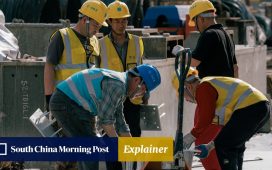“The daily average of mainland tourists visiting Hong Kong over the May golden week period used to exceed the 200,000 mark.”
Wong said that the spending power of solo travellers also went down by 20 per cent compared with pre-pandemic times.
“I urge the secretary [for culture, sports and tourism] to discuss with the central government as soon as possible allowing more cities to join the solo travellers’ scheme,” he said. “It’d be better for the food and beverage and retail sectors if more people are visiting.”
Wong explained sales in bars and restaurants were down by 20 per cent over last year because of fewer mainland visitors and their lower spending power, coupled with 180,000 Hongkongers who headed across the border on May 1.
But he said that the outlets on both sides of Victoria Harbour benefited from the fireworks display on May 1, which was credited for a 15 per cent increase in business compared with normal days.

Wong said about 100 visitors from the mainland cities of Xian and Qingdao had come to Hong Kong after the solo visitor scheme was updated for the first time since 2007.
Beijing in February added the two cities to the Individual Visit Scheme, which already covered 49 mainland cities, including many first-tier ones such as Beijing, Shanghai, Chengdu and Chongqing.
Tourists can make one or two visits to Hong Kong and Macau within three months or a year, up to a maximum of seven days.
Alan Chan Chung-yee, the chief operations officer of hotel and property company the Miramar Group, said business was “not ideal” over the holiday.
He said that his group’s two hotels recorded a 6 per cent and 7 per cent drop respectively in occupancy compared with last year, despite a 23 per cent price cut.
“Our suggestion of the most direct way [to boost the number of overnight guests] would be to increase the number of cities in the solo travellers’ scheme,” Chan said. “The vacancy rate of hotel rooms has even gone up since the launch of the solo travellers’ scheme in 2003 by 32 per cent.
“We need to communicate to the mainland that we could add 26 cities [connected to Hong Kong by high speed rail and by flight] to the scheme with no impact on the capacity.”

Wong said the solo traveller scheme needed a review since many of the 86 million people in the Greater Bay Area had already been to Hong Kong.
“How can we make Hong Kong more attractive to get repeat visitors?” he asked.
The bay area is Beijing’s plan to link Hong Kong and Macau with nine mainland cities to create an economic powerhouse.
Hong Kong leader John Lee Ka-chiu earlier pledged he would appeal to Beijing to expand the solo traveller scheme before the start of the golden week break.
Timothy Chui Ting-pong, the executive director of the Hong Kong Tourism Association, said competition from destinations in the rest of the country needed to be considered especially during peak holiday periods.
“There are many choices for mainlanders,” Chui said. “After the pandemic, tourism on the mainland is booming.
“There is direct competition between cities within the Greater Bay Area and between provinces.”
He added that the average number of visitors in the first three days of the five-day holiday period was “largely ideal” because on normal days the number of visitors stood at 80,000 to 10,000.
“At the same time, we realise that we have shortfalls,” Chui said. “The service quality needs improving, particularly when our competitors are doing very well. We can be better prepared.”







